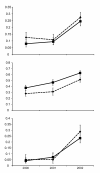Drug coverage in treatment of malaria and the consequences for resistance evolution--evidence from the use of sulphadoxine/pyrimethamine
- PMID: 20602754
- PMCID: PMC2908640
- DOI: 10.1186/1475-2875-9-190
Drug coverage in treatment of malaria and the consequences for resistance evolution--evidence from the use of sulphadoxine/pyrimethamine
Abstract
Background: It is argued that, the efficacy of anti-malarials could be prolonged through policy-mediated reductions in drug pressure, but gathering evidence of the relationship between policy, treatment practice, drug pressure and the evolution of resistance in the field is challenging. Mathematical models indicate that drug coverage is the primary determinant of drug pressure and the driving force behind the evolution of drug resistance. These models show that where the basis of resistance is multigenic, the effects of selection can be moderated by high recombination rates, which disrupt the associations between co-selected resistance genes.
Methods: To test these predictions, dhfr and dhps frequency changes were measured during 2000-2001 while SP was the second-line treatment and contrasted these with changes during 2001-2002 when SP was used for first-line therapy. Annual cross sectional community surveys carried out before, during and after the policy switch in 2001 were used to collect samples. Genetic analysis of SP resistance genes was carried out on 4,950 Plasmodium falciparum infections and the selection pressure under the two policies compared.
Results: The influence of policy on the parasite reservoir was profound. The frequency of dhfr and dhps resistance alleles did not change significantly while SP was the recommended second-line treatment, but highly significant changes occurred during the subsequent year after the switch to first line SP. The frequency of the triple mutant dhfr (N51I,C59R,S108N) allele (conferring pyrimethamine resistance) increased by 37% - 63% and the frequency of the double A437G, K540E mutant dhps allele (conferring sulphadoxine resistance) increased 200%-300%. A strong association between these unlinked alleles also emerged, confirming that they are co-selected by SP.
Conclusion: The national policy change brought about a shift in treatment practice and the resulting increase in coverage had a substantial impact on drug pressure. The selection applied by first-line use is strong enough to overcome recombination pressure and create significant linkage disequilibrium between the unlinked genetic determinants of pyrimethamine and sulphadoxine resistance, showing that recombination is no barrier to the emergence of resistance to combination treatments when they are used as the first-line malaria therapy.
Figures





References
Publication types
MeSH terms
Substances
Grants and funding
LinkOut - more resources
Full Text Sources

